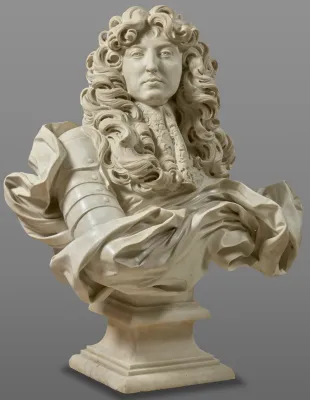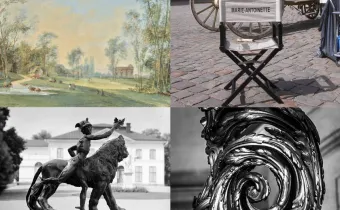A diplomatic trip, a royal commission
In 1665, the career of Gian Lorenzo Bernini (1598 - 1680), better known in France as “le Bernin”, was at its peak. He was the most famous sculptor and artist in Europe.
Louis XIV invited him to Paris at the suggestion of Colbert, Superintendent of the King’s Buildings. Pope Alexander VII gave him permission to undertake the trip, thus giving it a quasi-diplomatic status. This event sparked a wave of enthusiasm across Europe as it was the first time the sculptor had ever travelled outside Italy.
Bernini arrived in Paris on 2 June with his assistants. On 20 June, the king himself revealed the commission for his “portrait in marble”.
The sculptor set to work the next day and agreed to extend his stay in France to produce the bust, which was presented to Louis XIV on 5 October 1665.
Paul Fréart de Chantelou, a Deputy Master of the Royal Household, scholar and lover of Italy, was assigned by Colbert to accompany Bernini for the duration of his stay in France. He kept a very detailed diary of the trip. This valuable account tells us how the royal commission progressed, and reveals the interactions that took place between the artist and the king, and the reactions of the court. We even learn about some of the sculptor’s feelings.
Looking over the sculptor’s shoulder
We can also follow Bernini’s creative process virtually step by step, right through from ordering the marble to presenting the finished bust.
The sculptor began by establishing the “action” element of his work by immersing himself in the image and attitudes of his model using sketches made while the king was working with his advisors, granting audiences or playing tennis, without requiring him to pose. Bernini simultaneously created a clay model of the bust, which allowed him to define the general concept.
Work then began on the marble, which had been rough-hewn in advance by Bernini’s assistant Giulio Cartari. The sculptor set to work with gusto.
Lastly, Louis XIV granted the artist’s request and agreed to thirteen sittings as a special favour, during which Bernini sculpted every last detail of the sovereign’s face, including those which the king did not like.
This work became a form of entertainment and often took place in front of an audience of over forty courtiers gathered in the sculptor’s studio at the Mazarin Palace near the Louvre. This occasionally irked the artist. They all expressed their opinions and criticisms, which were noted by Chantelou and reported in the correspondence of the times.
An iconic work inspired by a genuine relationship between the king and the artist
On 5 October 1665, after more than three months of work, the bust was installed at the Louvre on a table covered in a gold cloth. Bernini declared that the work was finished at the end of this final sitting.
Chantelou describes the artist’s emotional reaction at that specific moment: “He told His Majesty that the work was finished, and that he hoped that its excellence was reflected in the fact that it was made with such great love, […] and when he had finished speaking these words, which were mispronounced, he began to cry and he could not speak any more, and withdrew, the King treated him with great honesty.”
This was the culmination of a genuine collaboration between the artist and his model. From the very outset, Bernini had considered this to be a joint enterprise with Louis XIV. Referring to the bust, the sculptor said: “The king and I have to finish it”. The artist was totally committed to the task and had no qualms about working long hours or jeopardizing his health; he even obtained royal permission to work on Sundays and public holidays.
For his part, Louis XIV was doubtless fully aware of the significance of this encounter with such a genius and of how the work could enhance his reputation. The king good-naturedly granted the artist’s various requests, including the many long sittings which he usually hated, and even apologized when he was unable to attend some of them. He feared for Bernini’s health as he worked tirelessly. He also reacted to the different stages of the creative process. He admired the work on his curls and the Venetian lace collar, worried about whether the bust was a true likeness and whether his nose was crooked.
Louis XIV was certainly aware that the finished portrait’s aura of majesty offered a fresh definition of the monarchy and its ambitions.
After these months of work, it was a measure of the king’s satisfaction that the bust was exhibited in public spaces as soon as it was finished: at the Louvre initially, then in the Tuileries.
In 1684, the bust was installed at the Palace of Versailles, which had become the state residence. It was placed in the Diana Room and has been there ever since. In the 17th century, visitors were greeted by this image of the Sun King as they emerged from the Ambassadors’ Staircase which led to the sovereign’s State Apartment. This prestigious symbolic position was chosen by Louis XIV as a mark of his fondness for works which were iconic emblems of his reign.
The exhibition
Restoration work in the Diana Room, where the bust is usually displayed at a distance in an elevated position, offers a special opportunity to discover Bernini’s masterpiece at eye-level for the first time, just as Louis XIV would have seen it when the artist unveiled it in 1665.
The exhibition brings together around this bust distinguished works which shed light on its genesis and influence. The first room presents the main protagonists of Bernini’s trip to France (2 June - 20 October 1665) which produced what some art historians consider to be “the most magnificent baroque portrait”.
The second room focuses on Bernini’s work and presents his influences and French responses to the masterpiece. French classicism comes face to face with Italian baroque – a counterpoint which would also mark the reign of Louis XV.
The works assembled at the Palace come from public and private collections in France and abroad, and tell the story of this key moment in the history of sculpture and in art history.
Curator
Lionel Arsac, Palace of Versailles Heritage Curator
Exhibition design
Antoine Fontaine





